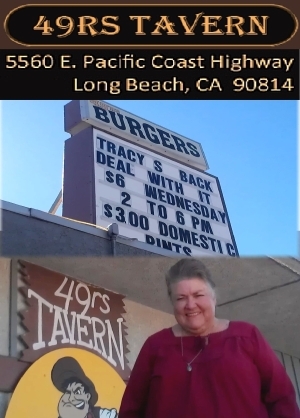Coastal Commission staff recommends Commission approval of the second paved path with conditions relating to setback from the high tide line, project timing, water quality, prohibiting future construction of shoreline protection devices to protect the structure and City Hall's assumption of risk...and says the City agrees with the recommendation.
Long Beach city management included the project as an item in City Hall's budget, which a City Council majority approved in September 2012 without detailed discussion of the specific proposal. The public works project is located in the portions of the 2nd and 3rd Council districts. The item is now on the Coastal Commission agenda for discussion and potential approval at its June 12-14 meeting which will take place in Long Beach.
[June 6 text added here, from previously indicated in Coastal Comm'n text below] A roughly 1,000 foot portion of the existing path will be moved inland near the La Verne Ave. parking lot, increasing the amount of open sand between the paths and ocean at that location by 170,000+ square feet, creating a larger sand area for kite surfers.
Additional salient portions of the Coastal Commission staff report and recommendations are below; the full staff report, with exhibits, can be viewed here.
SUMMARY OF STAFF RECOMMENDATION
The primary issue of the development proposal concerns the location of the proposed pedestrian path in relation to the high tide line and the existing concrete beach path. The City's proposed design places the alignment of the new pedestrian path closer to the water than the existing concrete beach path. Most of the beach along the 3.1-mile long path is sufficiently wide to accommodate the proposed second path along with a significant setback (over two hundred feet) from the surf zone (Exhibit #2). In the areas where the beach is relatively narrow, the City proposes to relocate the existing concrete beach path further inland in order to maintain the existing setback distance (at least fifty feet), or to provide an increased setback, between the proposed pedestrian path and the current surf zone.
Staff is recommending that the Commission approve a coastal development permit for the proposed development with special conditions relating to: setback from the high tide line, project timing, protection of water quality, prohibition on the future construction of shoreline protection devices to protect the structure, and the applicant’s assumption of risk. The City agrees with the recommendation.
III. SPECIAL CONDITIONS
This permit is granted subject to the following special conditions:
1. Setback from High Tide Line -- Revised Plans. The approved development (pedestrian path) shall be setback from the shoreline as follows. Prior to the issuance of the coastal development permit, the applicant shall submit revised project plans to the Executive Director for review and approval. The revised plans shall conform to, and clearly demonstrate compliance with, the following requirements:
A. For the segment of the new pedestrian path between Alamitos Avenue public beach parking lot and 9th Place, the new pedestrian path shall be parallel to the existing concrete path with a maximum ten-foot wide sand separation area between the two paths;
B. The new pedestrian path (and the existing concrete path) shall be located on the landward side of the 8th Place public restroom building;
C. For the segment of the new pedestrian path between 10th Place and Cherry Avenue, the new pedestrian path shall not be located any closer to the shoreline than the existing concrete path. The revised plans may include the relocation of the existing concrete beach path further inland so that the beach bicycle path and the new pedestrian path do not cross.
The permittee shall undertake the development in accordance with the final plans approved by the Executive Director pursuant to this condition. Any proposed changes to the approved plans shall be reported to the Executive Director in order to determine if the proposed change shall require a permit amendment pursuant to the requirements of the Coastal Act and the California Code of Regulations. No changes to the approved plan shall occur without a Commission amendment to this coastal development permit unless the Executive Director determines that no amendment is legally required...
...4. No Future Shoreline Protective Device. A) By acceptance of this coastal development permit, the applicant agrees, on behalf of itself and all successors and assignees, that no shoreline protective device(s) shall ever be constructed to protect the development approved pursuant to this coastal development permit including, but not limited to, the construction of the pedestrian path and bicycle path and any other future improvements, in the event that the development is threatened with damage or destruction from waves, erosion, storm conditions, liquefaction, sea level rise, or any other coastal hazards in the future. By acceptance of this permit, the applicant/landowner hereby waives, on behalf of itself and all successors and assigns, any rights to construct such devices that may exist under Public Resources Code Section 30235. B) By acceptance of this coastal development permit, the applicant/landowner further agrees, on behalf of itself and all successors and assigns, that the landowner shall remove the development authorized by this permit including, but not limited to, the pedestrian path and bicycle path, if any government agency has ordered that the structure is not to be used due to any of the hazards identified above. In the event that portions of the development become unsafe and unusable, the landowner shall remove all recoverable debris associated with the development from the beach and ocean and lawfully dispose of the material in an approved disposal site. Such removal shall require a coastal development permit.
5. Assumption of Risk, Waiver of Liability and Indemnity Agreement. By acceptance of this permit, the applicant, on behalf of 1) themselves; 2) their successors and assigns and 3) any other holder of the possessory interest in the development authorized by this permit, acknowledge and agree (i) that the site may be subject to hazards from waves, storm waves, flooding and erosion; (ii) to assume the risks to the applicant and the property that is the subject of this permit of injury and damage from such hazards in connection with this permitted development; (iii) to unconditionally waive any claim of damage or liability against the Commission, its officers, agents, and employees for injury or damage from such hazards; (iv) to indemnify and hold harmless the Commission, its officers, agents, and employees with respect to the Commission’s approval of the project against any and all liability, claims, demands, damages, costs (including costs and fees incurred in defense of such claims), expenses, and amounts paid in settlement arising from any injury or damage due to such hazards; and (v) to agree to include a provision in any subsequent sublease or assignment of the development authorized by this permit requiring the sublessee or assignee to submit a written agreement to the Commission, for the review and approval of the Executive Director, incorporating all of the foregoing restrictions identified in (i) through (v).
6. Liability for Costs and Attorneys Fees. By acceptance of this coastal development permit, the applicant agrees to reimburse the Coastal Commission in full for all Coastal Commission costs and attorneys fees -- including 1) those charged by the Office of the Attorney General, and 2) any court costs and attorneys fees that the Coastal Commission may be required by a court to pay -- that the Coastal Commission incurs in connection with the defense of any action brought by a party other than the applicant against the Coastal Commission, its officers, employees, agents, successors and assigns challenging the approval or issuance of this permit. The Coastal Commission retains complete authority to conduct and direct the defense of any such action against the Coastal Commission.
IV. FINDINGS AND DECLARATIONS
A. PROJECT DESCRIPTION
The applicant (City of Long Beach) is proposing to construct a 3.1-mile long pedestrian path on the beach between downtown (Alamitos Beach) and 54th Place in Belmont Shore (See Exhibits). The proposed eleven-foot wide pedestrian path would run on the seaward side of the existing concrete beach bicycle path which has been shared by all users since its construction in 1987 (Coastal Development Permit 5-87-001). The existing seventeen-foot wide concrete path has two bike lanes (eastbound and westbound) and one five-foot wide pedestrian lane. A narrow strip of sand (up to ten feet wide) would separate the new path from the existing path, except in some segments where there would be no separation between the two paths. The shoreline in the project area is a sandy public beach that exists in a stable and relatively low wave energy environment (because of the breakwater).
The City asserts that the proposed project will relieve overcrowding and reduce conflicts between the users (cyclists, walkers, runners and skaters) of the existing concrete beach path. The City proposes to construct the new path using a resin-based paving material in order to make the pedestrian path more flexible and conducive for running. No new lighting is proposed at this time.
The construction of the proposed project will require the reconfiguration of some existing development on the beach, including segments of the existing concrete beach path, several storm drain crossings, and the public parking lot on the east side of the Belmont Veterans Memorial Pier. The existing storm drain crossings will be widened by about twelve feet in order to accommodate the width of both the existing and proposed paths.
On the east side of the Belmont Veterans Memorial Pier, a new pedestrian/bicycle ramp is proposed to be constructed in order to eliminate the existing path’s dangerous right-angle turn coming off the pier. The proposed reconfiguration of the pier ramp will result in the loss of 32 parking spaces in the pier’s public parking lot (Exhibit #3). The segment of the existing beach bicycle path east of the pier would be relocated about forty feet landward (away from the ocean, closer to the Belmont Pool) in order to reduce the potential for damage resulting from waves and beach erosion.
In the vicinity of the La Verne Avenue public beach parking lot (south of Granada Launch Ramp), a 1000-foot long segment of the existing beach bicycle path would be moved landward in order to increase the amount of open sand area between the paths and ocean by over 170,000 square feet (Exhibit #4). The inland relocation of the bicycle path at this wide segment of the beach would create a larger sand area for kite surfers to set up their lines and sails.
At the Junipero Avenue public beach parking lot, the proposed project includes the removal of 7,700 square feet of turf from the area immediately inland of the parking lot in order to accommodate the proposed alignment of the new path inland of the lot. This turf area is popular for picnicking, so the City is proposing to mitigate the loss by planting 23,000 square feet of turf between the parking lot and the Bixby Park bluff, just east of the parking lot entrance/exit. Additional bike racks will be installed next to the public restrooms. Twenty palms will be relocated (a survey found no evidence of nesting bird activity in the trees). The City anticipates using part (about one-third) of Junipero Avenue public beach parking lot, and all of the La Verne Avenue public beach parking lot, for construction staging.
Construction staging activities include an aggregate and batch plant mixer for the resin based pavement material. Construction would be scheduled to avoid the summer season.
B. PUBLIC ACCESS AND RECREATION
One of the basic goals stated in the Coastal Act and is to maximize public access to and along the coast. The public access and recreation policies of the Coastal Act require that maximum access and recreational opportunities shall be provided and that development shall not interfere with such access.
Section 30210 of the Coastal Act states:
In carrying out the requirement of Section 4 of Article X of the California Constitution, maximum access, which shall be conspicuously posted, and recreational opportunities shall be provided for all the people consistent with public safety needs and the need to protect public rights, rights of private property owners, and natural resource areas from overuse.
Section 30211 of the Coastal Act states:
Development shall not interfere with the public's right of access to the sea where acquired through use or legislative authorization, including, but not limited to, the use of dry sand and rocky coastal beaches to the first line of terrestrial vegetation.
Section 30213 of the Coastal Act states:
Lower cost visitor and recreational facilities shall be protected, encouraged, and, where feasible, provided. Developments providing public recreational opportunities are preferred...
Section 30221 of the Coastal Act states:
Oceanfront land suitable for recreational use shall be protected for recreational use and development unless present and foreseeable future demand for public or commercial recreational activities that could be accommodated on the property is already adequately provided for in the area.
The public currently has unrestricted access along the entire shoreline where the pedestrian path is proposed. Numerous stairway and sidewalks provide vertical access between the City’s street-ends and the sandy beach. Several public parking lots are located on the beach itself. The existing seventeen-foot wide concrete beach path provides pedestrian and bicycle access between Downtown Long Beach and Alamitos Bay, connecting the City’s numerous recreational facilities together since 1987. The existing beach path is very popular and heavily used by cyclists, walkers, runners and skaters.
The City proposes to construct the new pedestrian path to relieve overcrowding and reduce conflicts between the users of the existing concrete beach path. A resin-based paving material, rather than concrete or asphalt, would be used to make the proposed pedestrian path more flexible and conducive for running. The proposed pedestrian path is a lower-cost recreational facility that will provide improved public access and recreational opportunities for cyclists, walkers, runners and skaters of all ages by providing a separate path for pedestrians. This separation of the two paths will make the beach safer for bicyclists and pedestrians.
The proposed re-alignment of segments of the existing concrete beach path will also increase the area of open sandy beach in two areas east of Belmont Veterans Memorial Pier: at Belmont Pool and La Verne Avenue (Exhibit #3&4).
Opponents of the proposed project object to the additional paving of the sandy beach and the proposed alignment of the pedestrian path on the seaward side of the existing concrete path, which would put people closer to the water and wild animals (Exhibit #5). Opponents also assert that the construction of the proposed project will hamper efforts to reconfigure the breakwater. Others are concerned about the loss of public parking near the pier.
The proposed project will pave more of the beach, but the additional paving will improve coastal access and provide lower-cost recreational opportunities to for cyclists, walkers, runners and skaters. The City considered putting the proposed pedestrian path on the inland side of the existing concrete path, but rejected the alternative because it would increase the cost of the project by about thirty percent. The City also state that the proposal to build the new pedestrian path on the ocean side of the bicycle path, similar to existing conditions, avoids crossings of the paths and lets pedestrians be closer to the water.
Some public parking (32 spaces) will be lost in the 263-stall public parking lot on the east side of the Belmont Veterans Memorial Pier where a new pedestrian/bicycle ramp is proposed to be constructed (Exhibit #3). The proposed ramp will eliminate the existing path’s dangerous right-angle turn coming off the pier. The City is not proposing to replace the parking spaces displaced by the proposed ramp. There is however, a much larger 753-stall public beach parking lot located one block east of the pier that will not be affected by the proposed project. The improved and safer bicycle and pedestrian access at the pier crossing is a benefit that will cost 32 public parking spaces. The use of the pier parking lot for the proposed ramp also allows the City to construct the new pedestrian and bicycle paths further inland (about twenty feet) from the high tide line than the existing concrete path, which will be demolished at this location. Thus, overall, the proposed project will increase non-motorized public access for the public, and thereby mitigate for the loss of these spaces, since there will be more space for the public to engage in recreational activities that cannot be performed on a sandy beach, like biking, roller skating, skateboarding and access for those with limited mobility due to disabilities or other physical challenges.
The impacts to public access caused by the construction of the proposed project will be limited and short-term. Some segments of the existing concrete beach path will be demolished as part of the project, and two public beach parking lots will be used as construction staging areas. In order to protect public access and recreational opportunities from short-term impacts caused by construction activities, the City has proposed to undertake construction during the non-summer season. Special Condition Two requires that the permitted development shall not occur during the “peak use” beach season (defined as the period starting the day before the Memorial Day weekend and ending the day after the Labor Day weekend), and that beach area closures shall be minimized and limited to areas immediately adjacent to the permitted development.
The use of part of the public beach and adjacent public parking lots for project staging will not have any significant adverse effect on public access or recreation because the parking lot and the beach have sufficient capacity to meet the low-season demands of the public when the proposed demolition and construction activities would occur. The public beach, public beach parking lots (except the La Verne Avenue public beach parking lot), and public restrooms will remain open throughout the construction period.
Concerns about future sea level rise and beach erosion are addressed in the next section (Hazards), which makes it clear that the proposed development should not be considered a permanent structure and future episodes of beach erosion and sea level rise will probably damage the development. Special Condition Four protects the public beach from further development by prohibiting the construction of future shoreline protective devices to protect the proposed pedestrian path and re-aligned bicycle path. Construction of a shoreline protective device between the proposed development and the sea would adversely affect public access and recreation by displacing public recreation area. Should the approved structure become damaged and deemed unsafe, the permittee would have to relocate or remove the development.
As conditioned, the proposed project will enhance public recreation and will not obstruct or interfere with existing public access or recreational opportunities at or near the project site. The proposed project does not: a) obstruct a significant view to or along the coast; b) adversely impact public access to and use of the water; c) adversely impact public recreational use of a public park or beach; or d) otherwise adversely affect recreation, access or the visual resources of the coast. Therefore, the Commission finds that, as conditioned, the proposed development will not have any significant adverse impact on public access to the coast or to nearby recreational facilities. Thus, as conditioned, the proposed development conforms with the public access and recreation policies of the Coastal Act.
C. HAZARDS
The Coastal Act states that new development must minimize risks to life and property and not create nor contribute significantly to erosion, geologic instability, or destruction of the site or surrounding area.
Section 30253 of the Coastal Act states, in part:
New development shall:
(l) Minimize risks to life and property in areas of high geologic, flood, and fire hazard.
(2) Assure stability and structural integrity, and neither create nor contribute significantly to erosion, geologic instability, or destruction of the site or surrounding area or in any way require the construction of protective devices that would substantially alter natural landforms along bluffs and cliffs.
The primary issue of the development proposal concerns the location of the proposed pedestrian path in relation to the high tide line and the existing concrete beach path. All beachfront property is subject to potential damage from wave run up and future beach erosion. The closer development is to the surf zone, the greater the likelihood of damage caused by waves and/or adverse storm conditions. Therefore, even on wide beaches, structures should be located as far from the surf zone as possible to assure stability and structural integrity.
In this case, the shoreline in the project area is a sandy public beach that exists in a stable and relatively low wave energy environment (because of the breakwater). The width of the beach varies widely: from less than two hundred feet between 10th and 14th Places, to more than five hundred feet east of Granada Avenue (Exhibit #2). During extreme high tides, the surf has come within a few feet of the existing concrete path near 11th Place. On past occasions, the surf has reached the existing concrete path in the Belmont Pier/Pool area, although the path was not damaged by the waves.
Therefore, it is important to acknowledge the fact that the proposed project is located in a dynamic setting (on the beach), where there is a potential for damage caused by waves and erosion. The City's proposal places the new pedestrian path on the seaward side of the existing concrete path so pedestrians can be closer to the water than bicyclists. Putting a new path between the existing concrete path and the water is problematic in the areas where the beach is narrow because there would be little room to provide an adequate setback from the surf zone.
The City has addressed this issue by agreeing to relocate the existing concrete beach path further inland in some areas in order to maintain the existing setback distance, or to provide an increased setback, between the proposed pedestrian path and the surf zone. On the east side of the Belmont Veterans Memorial Pier, the City proposes to demolish the existing concrete beach path and construct a combined bicycle and pedestrian path several feet inland of the existing alignment to create a larger buffer between the paths and the sea (Exhibit #3). This proposed alignment would eliminate 32 public parking spaces on the east side of the pier.
For the segment of the proposed pedestrian path between 10th Place and Cherry Avenue, where the beach is only about two hundred feet wide, the City has agreed to demolish the existing concrete beach path and construct a new combined bicycle and pedestrian path that would not encroach any closer to the sea than the existing concrete path. These changes in the alignment of the proposed pedestrian and bicycle paths would provide a setback of at least fifty feet between the proposed project and the highest observed high water line shown on Exhibit #2 (High Tide Observed 6/25/2012). Special Condition One requires the City to provide revised plans which show the new paths aligned no further seaward than the existing concrete path between 10th Place and Cherry Avenue.
In order to avoid any reduction in the narrow beach that exists on the seaward side of the Junipero Avenue public beach parking lot, the City has designed both the pedestrian and bicycle paths to run on the inland side of the parking lot (Exhibit #2, p.5). East of Junipero Avenue, the width of the beach increases substantially (except at Belmont Pool), giving the City sufficient space to construct the proposed pedestrian path on the seaward side of the existing concrete path while maintaining a setback of at least fifty feet between the proposed project and the highest observed high water line shown on Exhibit #2 (High Tide Observed 6/25/2012). For the stretch of beach between Junipero Avenue and Belmont Veterans Memorial Pier, the proposed pedestrian path is set back at least 250 feet from the shoreline (Exhibit #2).
No development on the beach, however, can be guaranteed to be safe from hazard. Even with a minimal setback of fifty feet, the proposed development is vulnerable to damage caused by wave energy and erosion (also floods, seismic events and storms). Therefore, the proposed development cannot be considered permanent and safe from such hazards, and the applicant is advised to anticipate that future episodes of beach erosion and sea level rise will very likely damage the development.
The Commission routinely imposes conditions for assumption of risk in areas at high risk from hazards. Special
Condition Five ensures that the permittee understands and assumes the potential hazards associated with the development.
Additionally, Special Condition Four prohibits the construction of future shoreline protective devices to protect the proposed pedestrian path. Should the development authorized by this permit (pedestrian path and bicycle path) be damaged and deemed unsafe, the permittee would have to relocate or remove the development, under a plan approved pursuant to a coastal development permit. As conditioned, the proposed project will not create or contribute significantly to erosion, geologic instability, or destruction of the site or surrounding area or in any way require the construction of protective devices that would substantially alter natural landforms along bluffs and cliffs. The project does not involve any landform alteration...
Developing.















